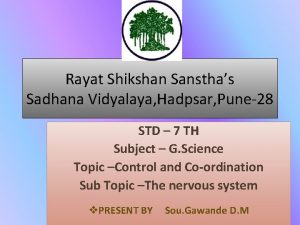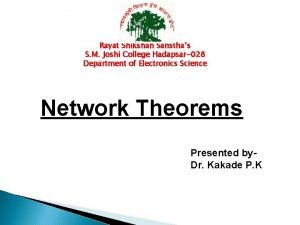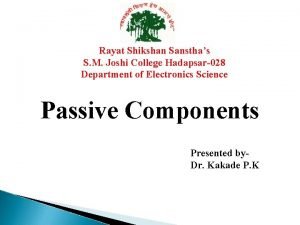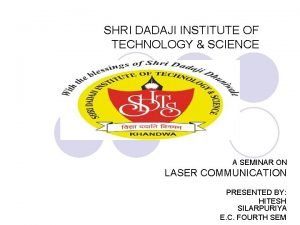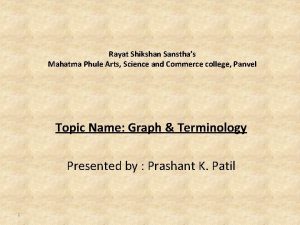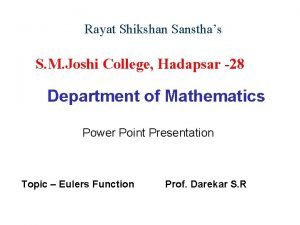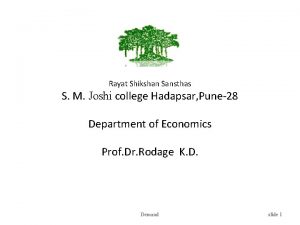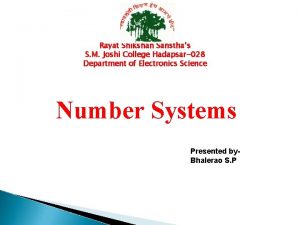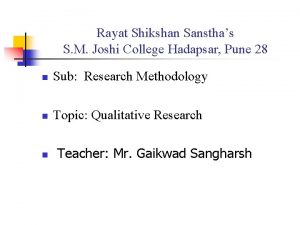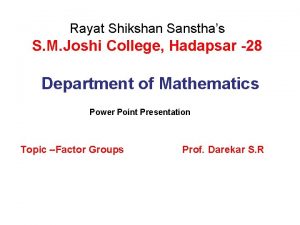Rayat Shikshan Sansthas Yashwantarao Chavan Institute of Science




































- Slides: 36

• Rayat Shikshan Sanstha’s Yashwantarao Chavan Institute of Science Satara Physics Std –XII Section – I Presentation on Elasticity By Mr. Ranmale V. B. & Mrs. Patil V. S.

Elasticity Introduction When a force is applied to a body, there are two possibilities 1) either state of the body changes i. e. body moves form its initial position F

Elasticity 2) or shape and/or size changes F If shape and/or size changes then that change is called as Deformation and the corresponding force is called as deforming force.

Elasticity By the use of Deformation all bodies can be classified as - Bodies Rigid Non-rigid Elastic Plastic

Elasticity What is Rigid body ? ? Rigid body is a body whose shape and/or size does not change even if a very high force is applied. e. g. : diamond or steel sphere Note : No body is rigid but for practical purposes we assume body to be a rigid body

Elasticity What is Non-Rigid body ? ? Non rigid body is a body whose shape and/or size changes if a very large force is applied. e. g. : Rubber band, steel or iron rod

Elasticity Property possessed by material body by virtue of which a material body opposes to change its shape or size or both when subjected to deforming force and regains its original shape and size when deforming forces are removed Elastic Body : An elastic body is a body which regains its original shape and/or size when deforming forces are removed. e. g. : Rubber

Elasticity Plasticity : Plastic Body : Property possessed by material bodies by virtue of which it do not regain its original shape or size or both after removal of external deforming force A plastic body is a body which does not regain its original shape and/or size when deforming forces are removed. e. g. : clay, dough etc.

Elasticity Distinguish between Elastic Body Plastic Body Elastic bodies regain original dimensions after removal of external forces Plastic bodies do not regain original dimensions after removal of external forces In elastic bodies intermolecular forces are strong In Plastic bodies intermolecular forces are weak Magnitude of external force required to change dimension is larger Magnitude of external force required to change dimension is small E. G. Steel , Iron , Quartz etc… E. G. Mud , clay , Pleistocene etc…

Elasticity elastic forces or restoring forces When external force is applied on a body , it gets deformed during deformation of body , internal forces are produced in body which opposes the change in dimensions of body such force are called as elastic forces or restoring forces The direction of internal restoring force is exactly opposite to applied force and magnitude is same as that of applied force. Deforming force Internal restoring force

Elasticity Definition of Stress and strain Stress is defined as the internal restoring force per unit area. The internal restoring force is equal and opposite to the deforming force. i. e. the applied force. Hence Stress is also defined as the applied force per unit area. Units : S. I. . Unit : N/m 2 C. G. S. Unit : dyne/cm 2 Dimensions : [M 1 L-1 T-2] Strain is defined as the ratio of change in dimension to original dimension. Since strain is the ratio of identical quantities therefore, it has no units and dimensions. Strain = Change in Dimensions Original Dimensions

Elasticity Types of Stress and strain Depending on nature of deformation stress and strain is of three types 1 ) Tensile Stress 1 ) Tensile Strain When force is applied at right angle to cross sectional area of wire then wire gets elongated and gives to stress which is perpendicular to cross sectional area. This stress is called as tensile stress If a force F = mg is applied to a wire of radius r having area of cross section A = r 2 Tensile stress = L l Mg Applied Force Area Is define as change in length per unit original length Tensile Strain

Elasticity Types of Stress and strain 2 ) Volume Stress When a body is subjected to increase in pressure then body is compressed. Thus the volume of body changes. Stress produced in body due to change in volume is called as volume stress 2 ) Volume Strain Change in volume per unit original volume is called as volume strain Volume strain = V-dv Volume stress = F = d. P A = Change in Pressure dv V

Elasticity 3 ) Shearing Stress When a tangential force is applied to one face of body with other face of body as fixed then the shape changes and stress is produced in the body. The stress produced due to change in shape of body is called as shearing stress A P S Types of Stress and strain B Q A A F P D C R Shearing stress S P D B Q Q C R B

Elasticity Types of Stress and strain 3 ) Shearing Strain Ration of lateral displacement of layer to its distance from fixed layer is called as shearing strain Lateral displacement of any layer Shearing strain = Its perpendicular distance from the fixed layer PP' = PS = x h Shearing = tan [. . . x <<< h Strain hence tan ] P P x F Q Q h S R

Elasticity Elastic Limits The maximum stress which can be applied to a body without permanently deforming it is called its elastic limit.

Elasticity Hook’s Law

Elasticity Hook’s Law Within elastic limits stress is directly proportional to strain . . . Stress Strain i. e. Stress Strain = Constant = E Robert Hook E is a constant of proportionality, or modulus of elasticity or coefficient of elasticity Units : S. I. Unit : N/m 2 C. G. S. Unit : dyne Dimensions : [M 1 L-1 T-2] /cm 2 Hooke's Law is obeyed only if the deformation is within the elastic limit. If the body is stretched beyond the elastic limit, stress is not proportional to the strain and Hooke's law is not obeyed.

Elasticity Elastic Constants 1) Young’s Modulus( Y) The ration of tensile stress to tensile strain is called as Young’s Modulus. . . Units : S. I. Unit : N/m 2 C. G. S. Unit : dyne /cm 2 Dimensions : [M 1 L-1 T-2] Only Solids have definite length. Therefore, Young’s modulus is the property of solids only

Elasticity Elastic Constants 2) Bulk Modulus( K) The ratio of volume stress to volume strain is called as Bulk Modulus. . Solid , liquid and gases all have Bulk modulus Units : S. I. Unit : N/m 2 C. G. S. Unit : dyne /cm 2 Dimensions : [M 1 L-1 T-2] Reciprocal of Bulk modulus is called as compressibility

Elasticity Elastic Constants 3) Modulus of rigidity ( η) The ratio of shearing stress to shearing strain is called as Modulus of Rigidity. . . If θ is small then tanθ = 0. Units : . . S. I. Unit : N/m 2 C. G. S. Unit : dyne /cm 2 Dimensions : [M 1 L-1 T-2] Particular shape. Therefore, Only solids possess modulus of rigidity

Elasticity Elastic Constants 4) Poisson's Ratio The ration of lateral contraction strain to longitudinal extension (Tensile) strain is called as Poisson’s ratio. . . s = . . . Value of Poisson’s ratio lies between -1 to 0. 5

Elasticity Wire length =1. 80 m Wire diameter =0. 27 mm Relations between the elastic constants Y, K h and s 1) Y = 3 K (1 – 2 s) 3) 2) Y = 2 h (1 + s) 4) or

Elasticity Determination of Young’s mo dulus by Sear le’s Method Apparatus

Elasticity R P S Q H S Level Fixed Variable

Elasticity R S P H Q S Level Fixed Variable

Elasticity R S P H Q S Level Fixed Variable

Elasticity Why do we require Searle’s Appt ? It is one of the correct method to determine elongation in the wire when it is loaded and this method is used to determine Young’s modulus of material of wire We know Load (M) That means to find Y we need to find l. O Extension (l) Graph is a straight line which shows that extension is proportional to the load according to Hooke’s Law. From this Y is Calculated as :

Elasticity Errors in the determination of elongation of wire and its elimination 1) Yielding of support Due to load to the wire the rigid support might bend by small amount. 2) Effect of temperature A change in room temp, will change the length of the wire as well Precautions By using two identical wires, so that if the rigid support bends, it will lower both the wires equally. Also if the temp. changes both wires will have equal change in length.

Elasticity

Elasticity Observation on a wire under applied increasing load Behavior of wire under increasing load is studied by applying load to the wire until wire breaks & corresponding elongation is noted by Searle’s apparatus Consider a long wire fixed to a rigid support & the other end stretched by suspending increasing loads. N E Y B E = Elastic limit P Stress P = Proportionality limit Y = Yield point N = Neck point B = Break point O O Strain

Elasticity Point P : proportionality limit : It is the point up to which stress is directly proportional to strain. Point E : Elastic limit : It is the point of maximum stress to which the wire can be subjected without permanent deformation. That means beyond E the wire will be stretched permanently even if the load is reduced and wire will not come back to original length. Point Y yield point : It is the point on the graph beyond which the wire becomes plastic such that strain increases even without stress. Point N : It is point on the graph where the length increases on its own due to the formation of a neck. Point B : It is the point where the wire breaks.

Elasticity Work done in stretching a thin uniform wire by calculus method When load is applied to a wire is elongated. During elongation of wire work is done on the wire by applied force. This work is stored in the form of potential energy called as strain energy Young’s modulus of material of wire is L A x …… (i) If wire if further elongated through dx , then the work done during the elongation is… d. W = f dx F

Elasticity Work done in stretching a thin uniform wire by calculus method Total work done during elongation of wire from 0 to l is L W = ∫ d. W A This work is stored in the form of potential energy called as strain energy Volume of cylindrical wire V=A L ……from (i) x F

Elasticity Therefore , Work done per unit volume in stretching a wire or strain energy per unit volume is … Strain energy is work done on the wire. Therefore, Work done per unit volume in stretching a wire As … OR

Elasticity
 Rayat shikshan sanstha sadhana vidyalaya hadapsar
Rayat shikshan sanstha sadhana vidyalaya hadapsar Rayat shikshan sanstha sadhana vidyalaya hadapsar
Rayat shikshan sanstha sadhana vidyalaya hadapsar Rayat shikshan sanstha kamothe
Rayat shikshan sanstha kamothe Rayat shikshan sanstha sadhana vidyalaya hadapsar
Rayat shikshan sanstha sadhana vidyalaya hadapsar Rayat shikshan sanstha loni
Rayat shikshan sanstha loni Rayat shikshan sanstha motto
Rayat shikshan sanstha motto Red rose
Red rose Apollonius theorem
Apollonius theorem Education through self help is our motto
Education through self help is our motto Yashwantrao chavan college
Yashwantrao chavan college उद्दीपकाचे
उद्दीपकाचे Smjoshi.rayat.dc
Smjoshi.rayat.dc Smjoshi.rayat.dc
Smjoshi.rayat.dc Smjoshi.rayat.dc
Smjoshi.rayat.dc Sawijining prosa lawas sing urip ing masyarakat
Sawijining prosa lawas sing urip ing masyarakat Smjoshi.rayat.dc
Smjoshi.rayat.dc Smjoshi.rayat.dc
Smjoshi.rayat.dc Mpasc.rayat.dc
Mpasc.rayat.dc Smjoshi.rayat.dc
Smjoshi.rayat.dc What is your favourite subject in college and why
What is your favourite subject in college and why Ramraj classes nashik
Ramraj classes nashik Ulsan national institute of science and technology
Ulsan national institute of science and technology Institute of industrial science the university of tokyo
Institute of industrial science the university of tokyo Masdar institute of science and technology
Masdar institute of science and technology Madhav institute of technology and science
Madhav institute of technology and science So cal science olympiad
So cal science olympiad Korea institute of sport science
Korea institute of sport science Schorarly
Schorarly Informing science institute
Informing science institute Science olympiad summer institute
Science olympiad summer institute Iist pune
Iist pune Hong kong institute of technology
Hong kong institute of technology Shri dadaji institute of technology and science
Shri dadaji institute of technology and science University
University Weizmann institute of science
Weizmann institute of science Msoe protein modeling
Msoe protein modeling Philadelphia job corps life science institute
Philadelphia job corps life science institute



